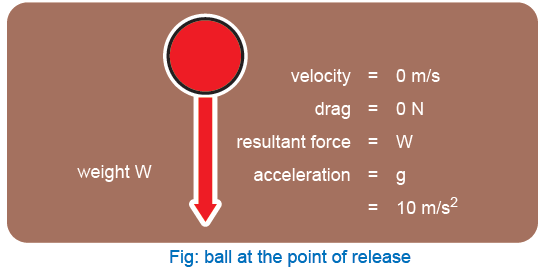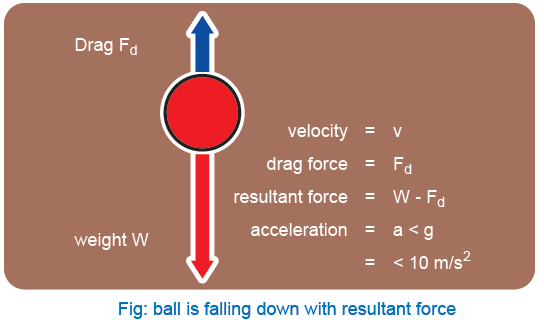
As the object speeds up the air resistance also increases, which is also known as drag force. The object is still accelerating but the acceleration is less as compared to the first case when it was just released because the resultant downward force decreases.

As the velocity of the object continues to get faster and faster, the resistive force of air increases and resultant force pulling it down decreases. Eventually the drag force is balanced by the weight of the object as shown in the following figure.
The resultant force is now zero. The object moves with a constant velocity called the terminal velocity.

Velocity - time Graph of Terminal Velocity
The way in which acceleration changes with time is shown in the following graph. The gradient of velocity-time graph is greater in the beginning. As air resistance increases, the gradient starts decreasing because the resultant force acting on the object starts decelerating.

Terminal Velocity Depends upon Shape and Area
The terminal velocity of a falling object depends upon how big the air resistance is. Air resistance depends upon two factors:
- The shape of the falling object - how streamlined it is.
- The area of the falling object.
Jumping of a Sky-diver
When a sky-diver jumps from a helicopter without opening the parachute, the only force acting on him is his weight. The skydiver has a small area and is quite streamlined. As he moves faster towards the ground, air resistance increases and eventually it becomes equal to his weight which is acting downwards.
When the both forces become equal, there is no resultant force. He stops accelerating and travels with constant speed, known as terminal speed. Sky-diver's terminal velocity is approximately 50 m/s.

When the sky-diver opens the parachute, the large area of the opened parachute increases the air resistance which is acting upwards. For a very short time interval its air resistance becomes greater than the weight of the sky-diver, but so resultant force acts upwards and paratrooper decelerates. As the paratrooper slows down the magnitude of the dragging force decreases, a new terminal velocity is reached.

The following velocity - time graph shows two stages of the terminal velocity. Stage P to Q shows the high value of terminal velocity of falling sky-diver without opening parachute. Stage R to S is the low value of terminal velocity when the sky-diver is moving with opened parachute with constant velocity.


